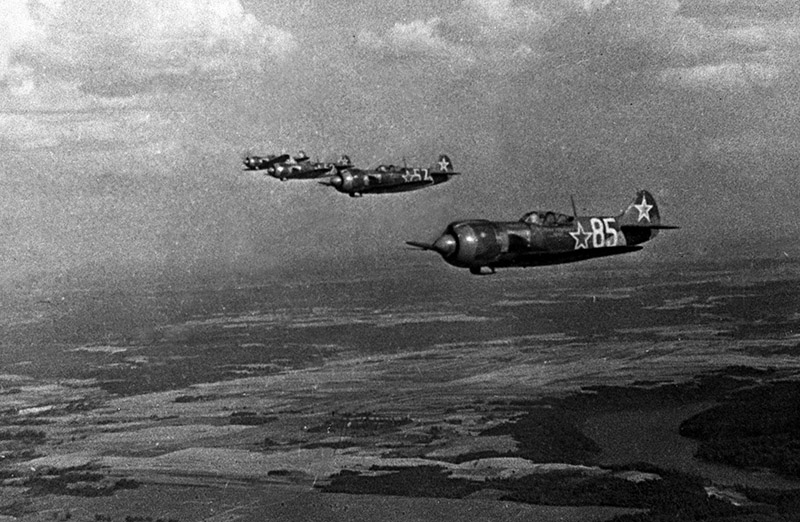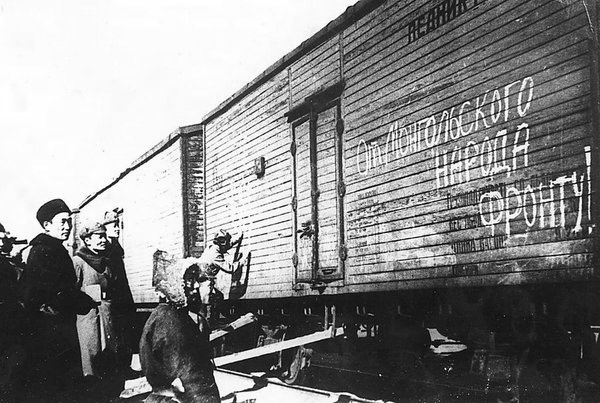[Special coverage] Furs, horses, aircrafts: How Mongolia did its part in WWII Victory

La-5FN fighters group of the Mongolian Arat squadron, 2nd Guards Fighter Aviation Regiment, 322nd Fighter Aviation Division, in flight. Source: visualrian.ru (RIA Novosti/Sputnik).
As soon as Hitler Germany and its allies committed aggression against the Soviet Union on June 22, 1941, оn the same day, a meeting of the Presidium of the Central Committee of the Mongolian People’s Revolutionary Party, the Presidium of the Khural MPR and the Council of Ministers of the MPR took place. The meeting decided to confirm fidelity to the obligations undertaken by Mongolia in accordance with the Protocol on Mutual Assistance between the MPR and the USSR of March 12, 1936. The most important task of the Mongolian people and state was proclaimed assistance to the Soviet Union in the fight against Hitler Germany. It was emphasized that only victory over fascism is a goal. A. Ariunzayaa specially for the Pan Pacific Agency.
At the call of the government of the MPR, brigades were set up in aimags (Mongolian word ‘aimag’ originally means ‘tribes’, is an administrative subdivision in nowadays) to harvest furs and meat. Warm clothes and meat products were sent to the Soviet Union – for transfer to the fighting units of the Red Army.
In October 1941, the first echelon formed by the citizens of the country with the help of the Red Army fighters was sent from Mongolia. He was carrying 15 thousand sets of winter uniforms, about 3000 individual parcels totaling 1.8 million tugriks. In addition, the USSR State Bank received 587 thousand tugriks in cash for expenditure purposes.
In total, in the first three years of the war, eight echelons were sent from Mongolia to the Soviet Union. They delivered food products, uniforms and other necessary things for a total amount of 25.3 million tugriks. The last ninth train of 127 wagons was dispatched in early 1945.
Here is an approximate list delivered by only one of the trains – in November 1942: short fur coats – 30,115 pcs .; felt boots – 30 500 pairs; fur mittens – 31,257 pairs; fur vests – 31 090 pcs.; soldier belts – 33 300 pcs.; woolen sweatshirts – 2 290 pcs.; fur blankets – 2 011 pcs.; berry jam – 12 954 kg; carcasses of gazelles – 26,758 pcs .; meat – 316,000 kg; individual parcels – 22,176 pcs .; sausage – 84 800 kg; oil – 92,000 kg.

The Secretary-General of the Central Committee of the MPRP, Y. Tsedenbal, in his report at the meeting of the party activist of the city of Ulan Bator on October 6, 1942 stated: “It is necessary to understand and explain to every working people of the MPR that only the defeat of fascism will save our country from the threat of military attack, from all those horrors that the peoples of the warring countries are now experiencing, that all that we can, we must give back to achieve this goal, without which no momentary prosperity will be lasting.”
Mongolia also contributed to equipping Soviet military aircraft. In 1943, fundraising began for the citizens of Mongolia for the acquisition of an aviation squadron, which was called the ‘Mongolian Arat’. 2 million Tugriks were transferred for the purchase of aircraft in July 1943.
On August 18, I.V. Stalin personally expressed gratitude to the leadership of the Mongolian People’s Republic for their assistance in forming the squadron: “To the Prime Minister of the MPR, Marshal Choibalsan. On behalf of the Soviet Government and my own, I express my heartfelt gratitude to you and, on your behalf, the government and people of the Mongolian People’s Republic who have gathered two million Tugriks to build the Mongolian Arat combat aircraft squadron for the Red Army, which is waging a heroic struggle against the Nazi invaders. The desire of the MPR workers to build a squadron of Mongolian Arat combat aircraft will be fulfilled. I. Stalin, August 18, 1943.”
The transfer of 12 La-5 squadron aircraft to the Soviet command took place at a field airfield at Vyazovaya station in the Smolensk region, on September 25, 1943, the Mongolian arat squadron became part of the 2nd Guards Regiment of the 322nd Fighter Aviation Division. The first commander of the ‘Mongolian Arat’ squadron was Hero of the Soviet Union Guard Captain N.P. Pushkin.
The contribution of Mongolia to equipping the Red Army with horses was invaluable. In fact, only Mongolia, with the exception of the Soviet Union itself, provided the Red Army with horses.
In Mongolia, a ten-hour work day was officially introduced. A huge part of the livestock was withdrawn by the state for the support needs of the Union Soviet state.
Thus, throughout the entire period of World War II, Mongolia provided substantial and invaluable assistance to the fighting Red Army and the Soviet people.